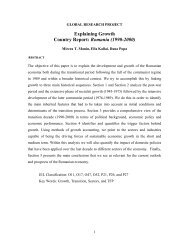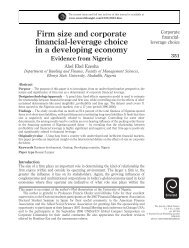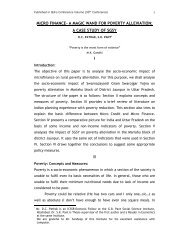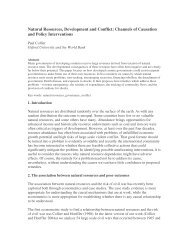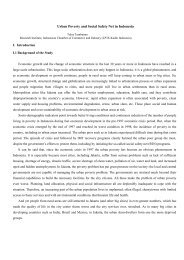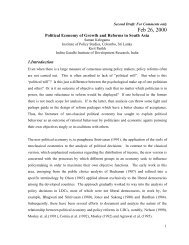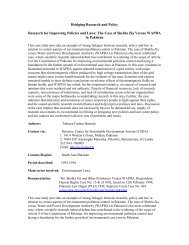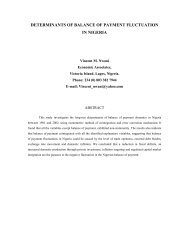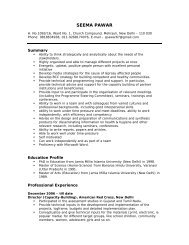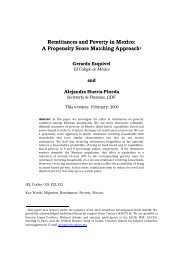biotechnology to benefit small-scale banana producers in kenya
biotechnology to benefit small-scale banana producers in kenya
biotechnology to benefit small-scale banana producers in kenya
You also want an ePaper? Increase the reach of your titles
YUMPU automatically turns print PDFs into web optimized ePapers that Google loves.
BIOTECHNOLOGY TO BENEFIT SMALL-SCALE<br />
BANANA PRODUCERS IN KENYA<br />
Florence Wambugu 1 , Margaret Karembu 2 , Michael Njuguna 1<br />
and<br />
Samuel Wakhusama Wanyangu 1<br />
1 The International Service for the Acquisition of Agri-biotech Applications (ISAAA), ISAAA<br />
AfriCentre, C/o CIP, P.O. Box 25171 Nairobi, Kenya, Tel: 254-2632054/151, e-mail:<br />
F.Wambugu@cgiar.org<br />
2 Department of Environmental Studies, Kenya University, P.O. Box 43844, Nairobi, Kenya.<br />
Tel: 254-2-810901, e-mail: karembu@hotmail.com<br />
_______________________________________________________________________<br />
ABSTRACT<br />
This project was conceived <strong>in</strong> response <strong>to</strong> the rapid decl<strong>in</strong>e <strong>in</strong> <strong>banana</strong> (Musa) production experienced <strong>in</strong> Kenya<br />
over the last two decades. The decl<strong>in</strong>e was brought about by: <strong>in</strong>festation with Panama disease or Fusarium wilt<br />
caused by Fusarium oxysporum f. sp. Cubense (FOC); Black and Yellow siga<strong>to</strong>ka leaf spot caused by<br />
Mycosphaerella fijiensis (Morelet) and Mycosphaerella musicola (Leach) respectively; weevils (Cosmopolites<br />
sordidus) / nema<strong>to</strong>de (Radopholus similis) complexes; and, environmental degradation. The common farmer<br />
practice of us<strong>in</strong>g untreated sword suckers aggravated the problem further. The situation threatened food security,<br />
employment and <strong>in</strong>come <strong>in</strong> <strong>banana</strong> produc<strong>in</strong>g areas. Thus the broad goal of the project was <strong>to</strong> make available <strong>to</strong><br />
<strong>small</strong>-<strong>scale</strong> resource-poor farmers clean and improved <strong>banana</strong> seedl<strong>in</strong>gs <strong>to</strong> alleviate the <strong>in</strong>creas<strong>in</strong>g poverty and<br />
hunger <strong>in</strong> Kenya. These farmers make up <strong>to</strong> nearly 80% of the Kenyan population and their agricultural production,<br />
which is ma<strong>in</strong>ly subsistence, contributes over 90% of food production <strong>in</strong> the country. The application of tissue<br />
culture (TC) technology <strong>to</strong> address these constra<strong>in</strong>ts, was therefore an appropriate option <strong>to</strong> ensure availability of<br />
clean plant<strong>in</strong>g material. The specific objectives of the project were <strong>to</strong> build and upgrade <strong>banana</strong> TC capacity <strong>in</strong><br />
Kenya by (i) systematically <strong>in</strong>troduc<strong>in</strong>g the technology <strong>to</strong> farmers and support<strong>in</strong>g them with the necessary extension,<br />
(ii) establish<strong>in</strong>g public/private sec<strong>to</strong>r l<strong>in</strong>ks <strong>to</strong> ensure timely availability of the TC materials, (iii) carry<strong>in</strong>g out a<br />
technology diffusion study <strong>to</strong> understand and appropriately respond <strong>to</strong> any issues that may limit adoption of the<br />
technology and (iv) develop<strong>in</strong>g a susta<strong>in</strong>able production-distribution-utilisation system as a means of ensur<strong>in</strong>g food<br />
security and creat<strong>in</strong>g jobs. To a large extent, the feasibility and appropriateness of the technology with<strong>in</strong> the farm<strong>in</strong>g<br />
system of <strong>small</strong>holder farmers was established. However, several issues relat<strong>in</strong>g <strong>to</strong> the eventual large-<strong>scale</strong><br />
commercialisation of the technology emerged. The first one was the need <strong>to</strong> <strong>in</strong>clude an Integrated Pest<br />
Management (IPM) package <strong>in</strong> order <strong>to</strong> prolong the orchards’ longevity. Secondly, for farmers <strong>to</strong> reap maximum<br />
<strong>benefit</strong>s, it was found necessary that field management packages <strong>to</strong> safeguard the health of the plantlets and the<br />
environment be <strong>in</strong>cluded <strong>in</strong> the technology transfer package. Thirdly, the cost of plantlets was found <strong>to</strong> be an<br />
important limit<strong>in</strong>g fac<strong>to</strong>r <strong>to</strong> technology diffusion. As a result, access <strong>to</strong> credit for orchard establishment was found <strong>to</strong><br />
be essential. The project now sees a need <strong>to</strong> establish a susta<strong>in</strong>able system of wider evaluation and horizontal<br />
technology transfer through <strong>in</strong>volvement of a broad network of partners with comparative advantage <strong>to</strong> mobilise<br />
large-<strong>scale</strong> impact.<br />
Keywords: Banana, <strong>biotechnology</strong>, <strong>benefit</strong>s, Kenya, poverty alleviation, <strong>small</strong>-<strong>scale</strong> farmers, susta<strong>in</strong>ability, tissue<br />
culture<br />
_______________________________________________________________________<br />
GDN Award Competition
1.0 INTRODUCTION<br />
Kenyans obta<strong>in</strong> most of their food, livelihoods, employment and foreign exchange earn<strong>in</strong>gs from<br />
the agricultural sec<strong>to</strong>r, even though only 20% of the country’s terri<strong>to</strong>ry is arable land (CBS, 1996;<br />
Sombrock, et al., 1982). In addition, the population growth rate of over three percent per year<br />
registered <strong>in</strong> Kenya <strong>in</strong> recent years has placed an <strong>in</strong>creas<strong>in</strong>g stra<strong>in</strong> on the food production, <strong>in</strong>come<br />
and employment potential of the agricultural sec<strong>to</strong>r and its natural resources <strong>in</strong> the country. As a<br />
result, hunger and poverty levels have been on the <strong>in</strong>crease. Dependence on cash crops, such as<br />
coffee and tea, further restricts the availability of land for food production. At the same time, low<br />
levels of farm <strong>in</strong>puts and management, <strong>in</strong>adequate land for crop rotation among <strong>small</strong>holder<br />
farmers, who make up <strong>to</strong> 80% of the population, and lack of disease-free plant<strong>in</strong>g materials have<br />
recently resulted <strong>to</strong> higher pathogen pressure on farm<strong>in</strong>g systems than <strong>in</strong> the past years (Nyangi<strong>to</strong>,<br />
et al., 1986). Pests and pathogens become endemic <strong>in</strong> the soil while land scarcity limits the<br />
opportunity for rotational production so that many crops are planted <strong>in</strong><strong>to</strong> <strong>in</strong>fected soils,<br />
perpetuat<strong>in</strong>g the problems. The <strong>in</strong>tensification of agriculture has also implied accelerated depletion<br />
of soil as a natural resource or resulted <strong>to</strong> reduced productive capacity. All these fac<strong>to</strong>rs compound<br />
the problems and exacerbate the need for improvements <strong>in</strong> food productivity <strong>in</strong> the short term<br />
while ma<strong>in</strong>ta<strong>in</strong><strong>in</strong>g the productivity of the agricultural natural resource-base for future generations.<br />
There are several ways that poverty alleviation can be reduced <strong>in</strong> Kenya. One of them is <strong>to</strong><br />
<strong>in</strong>crease agricultural productivity per unit area of land. Among the agricultural crops that show great<br />
potential for <strong>in</strong>creased production is the <strong>banana</strong> (Musa). Indeed, the importance of <strong>banana</strong>s<br />
throughout the world, and <strong>in</strong> Kenya cannot be over-emphasized. The crop is the world’s third<br />
important starchy staple after cassava and sweet pota<strong>to</strong> (FAO, 1987). Its world production<br />
estimates are placed at 49.63 million <strong>to</strong>n, of which 6.44 million is grown <strong>in</strong> Africa, 20.31 million <strong>in</strong><br />
Asia, 13.31 million <strong>in</strong> South America, 1.5 million <strong>in</strong> Oceania, 7.66 million <strong>in</strong> Central America and<br />
0.42 million <strong>in</strong> Europe (INIBAP, 1991; Rob<strong>in</strong>son, 1996). It is ma<strong>in</strong>ly consumed domestically, with<br />
an annual per capita consumption of 220-460 Kg, provid<strong>in</strong>g more than 25% of the <strong>to</strong>tal calories<br />
consumed (INIBAP, 1991). In Kenya, and <strong>to</strong> a larger extent, the East African region, the crop is<br />
ma<strong>in</strong>ly grown and managed by <strong>small</strong>holder farmers, predom<strong>in</strong>antly peasant women. Table 1 shows<br />
the average <strong>banana</strong> production statistics for the prov<strong>in</strong>ces of Kenya dur<strong>in</strong>g the period 1996-1997.<br />
Table 1: Average <strong>banana</strong> production statistics for the prov<strong>in</strong>ces of Kenya (1996-1997)<br />
Prov<strong>in</strong>ce Area (ha) Production (t) Yield (t/ha) Production share<br />
2
(percent)<br />
Central 16,913 169,316 10.0 16.5<br />
Coast 5,743 55,341 9.6 5.4<br />
Eastern 9,669 97,144 10.0 9.5<br />
Nairobi 48 409 8.5 0.0<br />
North Eastern 271 1,522 5.6 0.1<br />
Nyanza 30,234 574,740 19.0 56.1<br />
Rift Valley 2,688 39,781 14.8 3.9<br />
Western 7,800 86,107 11.0 8.5<br />
Total 73,366 1,024,360 14.0 (average) 100.0<br />
Source: MALDM (1996, 1997).<br />
Besides be<strong>in</strong>g a source of carbohydrates, essential vitam<strong>in</strong>s and m<strong>in</strong>erals, <strong>banana</strong> is attractive <strong>to</strong><br />
<strong>small</strong>holder farmers because it is appropriate for <strong>in</strong>ter-cropp<strong>in</strong>g. Production beg<strong>in</strong>s with<strong>in</strong> 14<br />
months from plant<strong>in</strong>g and may last up <strong>to</strong> ten years thus br<strong>in</strong>g<strong>in</strong>g reliable family <strong>in</strong>come. Over the<br />
last two decades however, <strong>banana</strong> production <strong>in</strong> Kenya and the Eastern Africa region has been on<br />
the decl<strong>in</strong>e (MOA, 1994). This decl<strong>in</strong>e has been brought about by the <strong>in</strong>festation with Panama<br />
disease caused by Fusarium oxysporum f. sp. Cubense (FOC), Black and Yellow siga<strong>to</strong>ka caused<br />
by Mycosphaerella fijiensis (Morelet) and Mycosphaerella musicola (Leach) respectively, weevils<br />
(Cosmopolites sordidus)/ nema<strong>to</strong>de (Radopholus similis) complexes and environmental<br />
degradation. As a result, <strong>banana</strong>s have become <strong>in</strong>creas<strong>in</strong>gly costly (Figure 1) and no longer serve as<br />
a ready supply of highly nutritious food and cash for rural populations, particularly women and<br />
children. The situation threatens food, employment and <strong>in</strong>come security <strong>in</strong> <strong>banana</strong> produc<strong>in</strong>g areas.<br />
The common farmer practice of us<strong>in</strong>g <strong>in</strong>fected sword suckers has cont<strong>in</strong>uously perpetuated the<br />
spread of <strong>banana</strong> diseases and pests, which are estimated <strong>to</strong> reduce yields by up <strong>to</strong> 90% (MOA,<br />
1994) thus worsen<strong>in</strong>g the food security situation.<br />
3
Figure 1: Average retail prices of <strong>banana</strong> <strong>in</strong> major markets <strong>in</strong> Kenya between 1990-1994<br />
12<br />
10<br />
8<br />
6<br />
4<br />
2<br />
0<br />
Jan Feb Mar Apr May Jun Jul Aug Sept Oct Nov Dec<br />
1990 1992 1993 1994<br />
Source: Agricultural Statistics Section, Central Bureau of Statistics, 1994<br />
Unavailability <strong>to</strong> access clean plant<strong>in</strong>g materials for <strong>banana</strong> growers <strong>in</strong> Kenya and East Africa<br />
constitutes a priority problem s<strong>in</strong>ce <strong>banana</strong> contributes <strong>to</strong> the livelihoods of many as well as the<br />
nutritional needs, employment and <strong>in</strong>come for nearly 20 million people <strong>in</strong> the region. The<br />
<strong>in</strong>troduction of tissue culture (TC) techniques for <strong>banana</strong> propagation was thus perceived as hav<strong>in</strong>g<br />
the potential <strong>to</strong> help reverse the situation s<strong>in</strong>ce it would ensure timely availability of clean plant<strong>in</strong>g<br />
material. The basis of the technology is the ability of many plant species <strong>to</strong> regenerate a whole<br />
plant from a shoot tip. It entails us<strong>in</strong>g t<strong>in</strong>y shoot-tips as the starter propagation material, which is<br />
dissected <strong>in</strong><strong>to</strong> <strong>small</strong> pieces. The shoot-tips are then placed <strong>in</strong> a growth medium (<strong>in</strong> sterilised flasks)<br />
that conta<strong>in</strong>s glucose and other nutrients. A dosage of growth hormones or regula<strong>to</strong>rs is added <strong>in</strong><strong>to</strong><br />
the medium. Different hormones are added at different stages <strong>to</strong> enhance various processes of<br />
growth such as shoot <strong>in</strong>itiation, multiple shoots’ formation and root<strong>in</strong>g <strong>in</strong>duction at the f<strong>in</strong>al stage.<br />
These <strong>in</strong>duce vigour, commonly referred <strong>to</strong> as "hormonal kick," that br<strong>in</strong>gs the parent material <strong>to</strong> a<br />
juvenile stage, caus<strong>in</strong>g remarkable physiological changes that <strong>in</strong>fluence the agronomic<br />
characteristics of the emerg<strong>in</strong>g plant<br />
These observations have been consistent with other crops such as sugarcane, pyrethrum, trees, and<br />
4
flowers where the TC techniques have been applied. It has also been noted that these physiological<br />
adaptations dilute down <strong>in</strong> subsequent generations and are not heritable genetic changes. In the<br />
case of the <strong>banana</strong>, under temperate conditions, the changes take up <strong>to</strong> about the fourth generation<br />
<strong>to</strong> revert <strong>to</strong> the orig<strong>in</strong>al parent/traditional <strong>banana</strong> vigour and agronomic characteristics. Under<br />
tropical conditions however, the changes are expected <strong>to</strong> take a longer period, at least up <strong>to</strong> the<br />
sixth generation. This implies that the economic w<strong>in</strong>dow of enhanced production is limited <strong>to</strong> a<br />
period of four <strong>to</strong> six years before the plants must be replaced.<br />
In six months, up <strong>to</strong> 2,000 <strong>in</strong>dividual plants (plantlets) can be produced from a s<strong>in</strong>gle shoot. With<br />
the usual nursery sucker method, only about 10 suckers can be produced from one plant <strong>in</strong> the<br />
same amount of time. These plantlets are then transplanted <strong>in</strong><strong>to</strong> t<strong>in</strong>y pots and kept <strong>in</strong> the highly<br />
humid labora<strong>to</strong>ry atmosphere for 10 days <strong>to</strong> acclimatize and harden <strong>to</strong> the conditions of the natural<br />
environment. The relative humidity is then decreased gradually, until they are hard enough <strong>to</strong> be replanted<br />
<strong>in</strong> the greenhouse <strong>in</strong> bigger pots. After pott<strong>in</strong>g, they are ready for the field <strong>in</strong> two months,<br />
at which po<strong>in</strong>t they are about 30 cm high. The young tissue culture plantlets are extremely tender<br />
and sensitive <strong>to</strong> water stress, and they require special attention for at least five months if they are <strong>to</strong><br />
perform well. Plant<strong>in</strong>g out must therefore co<strong>in</strong>cide with the on-set of long ra<strong>in</strong>s unless irrigation is<br />
available.<br />
The sterile operational nature of tissue culture procedures excludes fungal, bacteria, and pests from<br />
the production system, which means that siga<strong>to</strong>ka, Panama disease, weevils, and nema<strong>to</strong>des cannot<br />
be transmitted through the TC micro-propagation process. However, viruses, such as the <strong>banana</strong><br />
bunch <strong>to</strong>p and the episomal form of <strong>banana</strong> streak virus, are not elim<strong>in</strong>ated by tissue cultur<strong>in</strong>g<br />
unless measures are taken <strong>to</strong> prevent the transmissions from happen<strong>in</strong>g (e.g., virus <strong>in</strong>dex<strong>in</strong>g). This<br />
project addressed this issue through an appropriate survey for disease <strong>in</strong>cidences <strong>in</strong> the country.<br />
It is <strong>in</strong> the context that TC had the potential <strong>to</strong> improve <strong>banana</strong> production amongst <strong>small</strong>holder<br />
farms that the overall project on Banana Biotechnology <strong>to</strong> Benefit Small-<strong>scale</strong> Banana Growers <strong>in</strong><br />
Kenya was conceived. The project <strong>in</strong>tended <strong>to</strong> build and upgrade <strong>banana</strong> TC capacity, <strong>to</strong> expand<br />
the genetic base of <strong>banana</strong> and the varietal choice for growers by exchang<strong>in</strong>g and <strong>in</strong>troduc<strong>in</strong>g<br />
selected superior <strong>banana</strong> varieties with enhanced pest and disease resistance and higher yield from<br />
reputable breed<strong>in</strong>g programmes <strong>in</strong> the world, develop a susta<strong>in</strong>able distribution system of the TC<br />
materials <strong>to</strong> the <strong>small</strong>holder farmers, and commercially evaluate the adaptability of this technology<br />
5
with<strong>in</strong> current farm<strong>in</strong>g practices <strong>in</strong> Kenya. Key concerns were the profitability and susta<strong>in</strong>ability of<br />
produc<strong>in</strong>g and us<strong>in</strong>g TC materials as a bus<strong>in</strong>ess venture, and its potential impact on hunger and<br />
poverty alleviation <strong>in</strong> Kenya and neighbour<strong>in</strong>g countries of Tanzania and Uganda.<br />
2.0 MATERIALS AND METHODS<br />
2.1 Hypothesis<br />
The work<strong>in</strong>g hypothesis of the project was that mak<strong>in</strong>g improved and clean <strong>banana</strong> plant<strong>in</strong>g<br />
material accessible <strong>to</strong> resource-poor <strong>small</strong>-<strong>scale</strong> <strong>banana</strong> growers <strong>in</strong> Kenya, through TC technology<br />
and collaborative sourc<strong>in</strong>g and distribution of TC <strong>banana</strong> plants, was feasible, cost effective and<br />
beneficial <strong>to</strong> farmers and the country. To test this hypothesis, a research design was developed<br />
that encompassed:<br />
• Establish<strong>in</strong>g a pilot facility focuss<strong>in</strong>g on four benchmark <strong>banana</strong> grow<strong>in</strong>g sites <strong>in</strong> Kenya and<br />
centred on the re<strong>in</strong>forcement of exist<strong>in</strong>g tissue culture facilities.<br />
• Develop<strong>in</strong>g appropriate methods of sourc<strong>in</strong>g starter materials from farmer-preferred varieties<br />
and br<strong>in</strong>g<strong>in</strong>g them <strong>to</strong> the labora<strong>to</strong>ry for propagation.<br />
• Establish<strong>in</strong>g appropriate l<strong>in</strong>ks among suitable partners <strong>in</strong> production, distribution, and market<strong>in</strong>g<br />
and the benchmark sites, thus creat<strong>in</strong>g a self-susta<strong>in</strong><strong>in</strong>g system.<br />
• Undertak<strong>in</strong>g field trials <strong>to</strong> determ<strong>in</strong>e the yield potential of local as well as <strong>in</strong>troduced TC<br />
germplasm under optimum and current farmer management conditions <strong>in</strong> the sites.<br />
2.2 Partnerships <strong>in</strong> technology development, acquisition, test<strong>in</strong>g and dissem<strong>in</strong>ation<br />
From the <strong>in</strong>ception of the project, the lead <strong>in</strong>stitution, the International Service for the Acquisition<br />
of Agri-biotech Applications (ISAAA) had a clear vision of the project’s direction. ISAAA identified<br />
the Kenya Agriculture Research Institute (KARI) as a suitable collabora<strong>to</strong>r <strong>to</strong> host the project based<br />
6
on the follow<strong>in</strong>g attributes: KARI had the comparative advantage of hav<strong>in</strong>g a network of research<br />
centres throughout the country, <strong>in</strong>clud<strong>in</strong>g the <strong>banana</strong> grow<strong>in</strong>g areas; it had the human resource<br />
capacity <strong>to</strong> conduct the on-station cultivar evaluations and agronomic studies for varieties that were<br />
not locally grown; and KARI had the necessary <strong>in</strong>frastructure <strong>to</strong> offer extension services.<br />
ISAA also identified a collabora<strong>to</strong>r <strong>to</strong> supply the <strong>in</strong>itial plant<strong>in</strong>g materials for both the KARI stations<br />
and the farmers’ fields. S<strong>in</strong>ce Kenya did not have sufficient capacity <strong>to</strong> supply the plantlets, DuRoi<br />
Labora<strong>to</strong>ries, a private company <strong>in</strong> South Africa with long experience <strong>in</strong> tissue culture<br />
multiplication was approached. This was important because the project needed <strong>to</strong> use high quality<br />
materials <strong>to</strong> make a dist<strong>in</strong>ction. A local counterpart private company <strong>in</strong> Kenya, Genetic<br />
Technologies Limited (GTL), was identified <strong>to</strong> handle the materials after they arrived from South<br />
Africa. Furthermore, GTL had experience with tissue culture work <strong>in</strong> other crops.<br />
Technical backs<strong>to</strong>pp<strong>in</strong>g was considered crucial <strong>to</strong> the success of the project. The Institute of<br />
Tropical and Sub-tropical Crops (ITSC), a public <strong>in</strong>stitution of South Africa, was identified as<br />
possess<strong>in</strong>g the relevant experience and human resource capacity <strong>to</strong> perform this task. The John<br />
Innes Centre of UK was identified <strong>to</strong> conduct virus diagnostics.<br />
ISAAA identified the Rockefeller Foundation and the International Development Research Centre<br />
(IDRC) of Canada <strong>to</strong> fund the project. In addition, the African Technology Policy Studies (ATPS)<br />
network provided funds for <strong>banana</strong> technology diffusion research. This was important s<strong>in</strong>ce past<br />
experiences with new <strong>in</strong>novations have generally shown that if the needs and <strong>in</strong>terests of end-users<br />
are overlooked, then little adoption of the technology takes place. The Zentrum fur<br />
Entwicklungsforschung (ZEF) Center for Development Research, University of Bonn, Germany<br />
carried out an ex-ante impact assessment study. Table 2 shows a summary of the ma<strong>in</strong> activities of<br />
the partners <strong>in</strong>volved and their responsibilities on the project.<br />
7
Table 2: Summary of the ma<strong>in</strong> activities, <strong>in</strong>stitutions <strong>in</strong>volved and their responsibilities <strong>in</strong> the Kenyan TC <strong>banana</strong> project<br />
Objective Institutions Ma<strong>in</strong> output Remarks<br />
TC Production<br />
GTL, KARI, DuRoi Labora<strong>to</strong>ries Selection of varieties, TC production, quality control and Enhanced public/private, collaboration, and<br />
(S. Africa)<br />
assurance, tra<strong>in</strong><strong>in</strong>g <strong>in</strong> nursery management<br />
str<strong>in</strong>gent quality control<br />
Strategic/ adaptive research<br />
KARI, ATPS, ISAAA, Farmer<br />
groups.<br />
On-station trials, varietal comparisons, spac<strong>in</strong>g, agronomy,<br />
TC versus suckers comparisons, <strong>in</strong>ter-cropp<strong>in</strong>g, tra<strong>in</strong><strong>in</strong>g,<br />
demonstrations and technology diffusion<br />
Appropriate <strong>in</strong>frastructure and policy<br />
framework required<br />
Distribution<br />
KARI, ISAAA, CBOs, Farmer<br />
groups<br />
Distribution mechanism channels – Schools, Churches, onfarm<br />
trials, markets, village leaders and farmers.<br />
Well designed market<strong>in</strong>g plan, entrepreneurial<br />
skills and will<strong>in</strong>gness <strong>to</strong> participate<br />
L<strong>in</strong>kages with farmers (end-users) KARI, ATPS, ISAAA Needs assessment through PRAs, varietal choices, orchard<br />
management, access <strong>to</strong> TC, on-farm trials<br />
Tra<strong>in</strong><strong>in</strong>g, TC/suckers, large and <strong>small</strong>-<strong>scale</strong> farms<br />
demonstrations and f<strong>in</strong>anc<strong>in</strong>g<br />
Participa<strong>to</strong>ry approach geared <strong>to</strong>wards<br />
meet<strong>in</strong>g farmer expectations and aspirations.<br />
Market<strong>in</strong>g/ Sell<strong>in</strong>g of products<br />
KARI, ATPS, ISAAA, ZEF<br />
(Germany) and Farmer groups.<br />
Socio-economics: pric<strong>in</strong>g, quality control, distribution and<br />
tra<strong>in</strong><strong>in</strong>g.<br />
Market structure establishment, packag<strong>in</strong>g<br />
standards<br />
Expansion (Indirect <strong>benefit</strong>s) Micro-entrepreneurs NGOs Manure bus<strong>in</strong>ess, micro-irrigation, Banana Growers<br />
Association, private <strong>in</strong>vestments e.g. <strong>banana</strong>-related<br />
bus<strong>in</strong>esses and export markets<br />
Political and economic stability required,<br />
entrepreneurial skills for identification of<br />
bus<strong>in</strong>ess opportunities<br />
Technical backs<strong>to</strong>pp<strong>in</strong>g<br />
ITSC (S. Africa), John Innes<br />
Centre (UK) and DuRoi<br />
Labora<strong>to</strong>ries (S. Africa).<br />
Design<strong>in</strong>g appropriate field management packages;<br />
commercialization strategy, disease diagnostics and tra<strong>in</strong><strong>in</strong>g<br />
Public-Public sec<strong>to</strong>r collaboration, network<strong>in</strong>g<br />
and experience shar<strong>in</strong>g<br />
NB: Fund<strong>in</strong>g was ma<strong>in</strong>ly from The Rockefeller Foundation and the IDRC. Key: CBOs = Community Based Organizations, NGOs = Non-Governmental Organizations,<br />
PRAs = Participa<strong>to</strong>ry Rural Appraisal.<br />
GDN Award Competition
2.3 Study sites<br />
Four <strong>banana</strong>-grow<strong>in</strong>g regions were identified: Thika <strong>in</strong> the Central Prov<strong>in</strong>ce, Kisii <strong>in</strong> the Nyanza<br />
Prov<strong>in</strong>ce, Embu <strong>in</strong> the Eastern Prov<strong>in</strong>ce, and Mtwapa <strong>in</strong> the Coast Prov<strong>in</strong>ce. These prov<strong>in</strong>ces<br />
adequately represented the major agro-ecological zones (AEZ) of Kenya. They are also the major<br />
<strong>banana</strong> grow<strong>in</strong>g regions <strong>in</strong> the country.<br />
The KARI research centers locally responsible for these regions were identified as l<strong>in</strong>k <strong>in</strong>stitutions<br />
<strong>to</strong> undertake demonstration trials and farm-level moni<strong>to</strong>r<strong>in</strong>g. To enhance the possibility of success,<br />
only the Thika and Kisii KARI centers <strong>to</strong>ok part <strong>in</strong> the first year of the project. Embu and Mtwapa<br />
centers were recruited <strong>in</strong> the subsequent years. This approach allowed the two centers tak<strong>in</strong>g part<br />
<strong>in</strong> the first year <strong>to</strong> receive the necessary support <strong>to</strong> overcome the <strong>in</strong>evitable “teeth<strong>in</strong>g” problems.<br />
Table 3 below gives the characteristics of the trial sites with<strong>in</strong> these areas.<br />
Table 3: The characteristics of sites where tissue culture <strong>banana</strong> trials <strong>to</strong>ok place<br />
Site Prov<strong>in</strong>ce AEZ Altitude<br />
(metre)<br />
Ra<strong>in</strong>fall<br />
(mm)<br />
Participat<strong>in</strong>g<br />
farmers<br />
NHRC-Thika Central UM 3 1500 900 On-station<br />
Kiharu-Maragwa Central UM 2 1400 1750 14<br />
Gathiga-Kir<strong>in</strong>yaga Central UM 4 1300 600-950 4<br />
RRC-Kisii Nyanza UM 1 1750 1800 On-station<br />
Kenyenya Nyanza UM 1 1700 1800 2<br />
Suneka Nyanza LM 2 1500 1500 12<br />
RRC-Embu Eastern UM 3 1500 1000-1250 On-station<br />
Embu-Gatituri Eastern UM 2 1450 1000-2000 6<br />
RRC-Mtwapa Coast CL 0-50 > 2000 On-station<br />
Mtwapa Coast CL 0-50 > 2000 1<br />
Key: NHRC = National Horticultural Research Centre, RRC = Regional Research Centre, UM = Upper Midland,<br />
LM = Lower midland, CL = Coastal l<strong>in</strong>e<br />
2.4 Performance and demonstration trials<br />
GDN Award Competition
On-farm and on-station TC evaluation trials were carried out under the supervision of KARI. TC<br />
<strong>banana</strong> plantlet cultivars of Ch<strong>in</strong>ese Cavendish, Gold F<strong>in</strong>ger, Valery, Grandna<strong>in</strong> and Dwarf<br />
Cavendish were tested. Comparison of performance was made between TC <strong>banana</strong>s versus<br />
conventional suckers, TC <strong>banana</strong>s versus first generation suckers and TC <strong>banana</strong>s versus first<br />
generation suckers. The overall objectives were <strong>to</strong> evaluate: performance of TC <strong>banana</strong> plantlets <strong>in</strong><br />
different AEZs; performance and farmer acceptability of different <strong>banana</strong> cultivars <strong>in</strong> farmers'<br />
fields; performance and other characteristics of <strong>in</strong>troduced/new <strong>banana</strong> cultivars; and, <strong>to</strong> develop<br />
reference po<strong>in</strong>ts for compar<strong>in</strong>g performance on farmers' fields. Other objectives were <strong>to</strong> f<strong>in</strong>d if<br />
there were any advantages <strong>in</strong> terms of yield, early maturity of crop and any other superior<br />
attributes of us<strong>in</strong>g TC plants as opposed <strong>to</strong> the conventional suckers and <strong>to</strong> f<strong>in</strong>d out if the first<br />
generation suckers from TC carried over the vigour potential the TC plants had <strong>in</strong>itially.<br />
Rout<strong>in</strong>e agronomic practices for <strong>banana</strong> were applied throughout the studies that were designed <strong>in</strong><br />
Randomised Complete Blocks with 3 replications.<br />
2.5 Independent socio-economic and impact study<br />
With support from ZEF, the project under<strong>to</strong>ok a socio-economic and ex-ante impact study of the<br />
TC <strong>banana</strong> technology. Data used <strong>in</strong> the analyses was based on a number fac<strong>to</strong>rs. Amongst these<br />
were:<br />
• Banana production statistics<br />
• Regional aspects of <strong>banana</strong> production<br />
• Correlation matrix for different characteristics of <strong>banana</strong> farms<br />
• Characteristics of <strong>banana</strong> farm types<br />
• Banana plantation establishment cost by farm type<br />
• Recurrent annual cost of <strong>banana</strong> production by farm type<br />
• Average <strong>banana</strong> cost and <strong>in</strong>come figures by farm type<br />
• Banana plantation establishment cost without and with TC technology<br />
• Recurrent annual cost of <strong>banana</strong> production without and with the use of TC technology<br />
• Average <strong>banana</strong> cost and <strong>in</strong>come figures without and with the use of TC technology<br />
• Technology-<strong>in</strong>duced changes <strong>in</strong> cost and <strong>in</strong>come figures under different price assumptions<br />
for TC plants (percent)<br />
10
• Estimated technology adoption rates under different price assumptions for TC plants<br />
(percent)<br />
• Benefits and distribution effects of the technology for different scenarios.<br />
Qaim, (1999) details the analyses carried out <strong>to</strong> establish the ex-ante impact of the TC <strong>banana</strong>.<br />
2.6 Technology diffusion studies<br />
This was carried out by means of a survey <strong>in</strong> the study areas. Data was collected on variety<br />
preferences and social acceptance, compatibility of TC <strong>banana</strong> with the exist<strong>in</strong>g farm<strong>in</strong>g practices,<br />
the potential impact of the cost of TC plantlets on the diffusion of TC technology, gender issues<br />
with regard <strong>to</strong> the technology, market<strong>in</strong>g of <strong>banana</strong>s and techno-managemental practices.<br />
3.0 RESULTS<br />
3.1 Results of performance trials<br />
The performances of the demonstration trials were excellent. On average, <strong>small</strong>-<strong>scale</strong> farmers<br />
harvested <strong>banana</strong>s with a bunch weight of more than 40kg compared <strong>to</strong> the usual average of 15-<br />
30Kg (MOA, 1994). The trials also created enormous <strong>in</strong>terest among <strong>small</strong>-<strong>scale</strong> farmers,<br />
especially <strong>in</strong> the project areas. As a result, the demand for tissue culture plant<strong>in</strong>g materials has<br />
<strong>in</strong>creased tremendously. To facilitate the acquisition of these materials, KARI and ISAAA<br />
collaborated <strong>to</strong> identify a church group and several key farmers <strong>in</strong> different areas <strong>to</strong> establish<br />
nurseries and distribution po<strong>in</strong>ts. Farmers <strong>in</strong> project areas can now access clean TC plant<strong>in</strong>g<br />
materials through these nurseries. The role of the project was <strong>to</strong> help <strong>in</strong> the establishment of the<br />
nurseries, distribution po<strong>in</strong>ts, and the l<strong>in</strong>k between the TC source and the nurseries. This strategy<br />
was meant <strong>to</strong> ensure the susta<strong>in</strong>ability of the project after the fund<strong>in</strong>g period came <strong>to</strong> an end.<br />
3.2 Results of an <strong>in</strong>dependently conducted socio-economic impact study<br />
An <strong>in</strong>dependent socio-economic impact study demonstrated that the average per acre <strong>in</strong>comes for<br />
<strong>small</strong>, medium, and large-<strong>scale</strong> farms could rise by 156, 145, and 106 % respectively (Qaim,<br />
1999). This was <strong>in</strong> complete contrast <strong>to</strong> the traditional belief that <strong>small</strong>-<strong>scale</strong> farmers cannot <strong>benefit</strong><br />
from modern biotechnological applications. The study also demonstrated both the high profitability<br />
11
of the <strong>in</strong>cremental <strong>in</strong>vestments required for the technology package and the general suitability of<br />
TC for all farm types. In addition, the study has shown that us<strong>in</strong>g the TC technology would<br />
considerably <strong>in</strong>crease the net return on labour for all producer groups, an important criterion given<br />
the relative labour scarcity <strong>in</strong> the <strong>in</strong>dividual farm household.<br />
From the same study, it is evident that the TC technology is likely <strong>to</strong> br<strong>in</strong>g about substantial<br />
aggregate growth <strong>in</strong> the welfare of the Kenyan <strong>banana</strong> sec<strong>to</strong>r, regardless of the underly<strong>in</strong>g<br />
assumptions of the cost for <strong>in</strong> vitro plants. A recent survey conducted <strong>in</strong> Central Kenya, one of the<br />
field trial zones, has reported that some farmers are will<strong>in</strong>g <strong>to</strong> pay as much as US$3 per plantlet!<br />
This is obviously a result of the demonstrated relative advantages and economic promise associated<br />
with the adoption of the TC technology. The projected average annual change <strong>in</strong> the <strong>to</strong>tal<br />
economic surplus ranged from US$ 8 <strong>to</strong>12 million dollars (Qaim, 1999).<br />
Other <strong>in</strong>terest<strong>in</strong>g features, often neglected <strong>in</strong> producer-oriented evaluations of farm technology, are<br />
the advantages for food consumers. The impact assessment study showed that productivity ga<strong>in</strong>s<br />
could cause <strong>banana</strong> prices <strong>to</strong> decl<strong>in</strong>e. This would improve the real <strong>in</strong>come situation of purchasers<br />
and thus their welfare. The study has revealed that consumers would capture between 40 and 55<br />
percent of the <strong>to</strong>tal economic surplus ga<strong>in</strong>s.<br />
3.3 Results of the technology diffusion study.<br />
3.3.1 Variety preference and social acceptance<br />
Results obta<strong>in</strong>ed showed that the varieties <strong>in</strong>itially supplied by the project <strong>to</strong> farmers were not<br />
preferred and they became <strong>in</strong>different <strong>to</strong> the technology. One such unpopular variety is the Dwarf<br />
Cavendish. The study showed that farmers preferred their own varieties, hence the project focus<br />
changed <strong>to</strong> transform the farmers’ orchards from traditional <strong>to</strong> TC materials. The bunch size of<br />
the improved traditional <strong>banana</strong> varieties was much bigger.<br />
3.3.2 Compatibility of TC technology with exist<strong>in</strong>g farm<strong>in</strong>g practices<br />
Farmers did not report any problems with their cropp<strong>in</strong>g system and thus the improved TC <strong>banana</strong><br />
did not seem <strong>to</strong> affect other crops <strong>in</strong> the <strong>in</strong>ter-cropped farms.<br />
12
3.3.3 Cost of plantlets<br />
Despite the fact that under traditional farm<strong>in</strong>g practice, farmers usually obta<strong>in</strong>ed free swords from<br />
their neighbours <strong>to</strong> plant, it was encourag<strong>in</strong>g <strong>to</strong> note that with the demonstrated superiority of TC<br />
<strong>banana</strong>, they were will<strong>in</strong>g <strong>to</strong> pay for the TC plantlets whose cost ranged from one <strong>to</strong> two US$. The<br />
ma<strong>in</strong> constra<strong>in</strong>t for farmers <strong>to</strong> obta<strong>in</strong> the TC plantlets was found <strong>to</strong> be a convenient supply.<br />
3.3.4 Gender issues <strong>in</strong> TC <strong>banana</strong> technology<br />
An <strong>in</strong>terest<strong>in</strong>g observation from the field study was that despite <strong>banana</strong> be<strong>in</strong>g a predom<strong>in</strong>antly<br />
woman’s crop, there were divisions as <strong>to</strong> which varieties could be marketed by which gender. In<br />
Kisii for <strong>in</strong>stance, the women ma<strong>in</strong>ly marketed apple <strong>banana</strong>, which is <strong>small</strong> and does not fetch<br />
much money. Men on the other hand marketed the cook<strong>in</strong>g type (Ekeganda Grade and Ng’ombe),<br />
which is much bigger and fetches more money on the market. The <strong>banana</strong> TC attracted more men<br />
although there did not seem <strong>to</strong> be much competition for land as had been envisaged. It was<br />
encourag<strong>in</strong>g <strong>to</strong> note that men were supportive of the technology and as household heads who make<br />
decisions on what is <strong>to</strong> be planted, this aspect did not affect the adoption of the technology.<br />
3.2.5 Market<strong>in</strong>g<br />
Due <strong>to</strong> <strong>in</strong>creased production, there def<strong>in</strong>itely existed a market problem and middle traders were<br />
<strong>in</strong>creas<strong>in</strong>gly exploit<strong>in</strong>g farmers. Current market studies are address<strong>in</strong>g this problem. Meanwhile,<br />
farmers have been encouraged <strong>to</strong> form market<strong>in</strong>g associations that could regulate the prices and<br />
also develop proper market<strong>in</strong>g plans and s<strong>to</strong>rage facilities <strong>to</strong> enable them <strong>benefit</strong> from the realised<br />
yields. The formation of a Banana Growers Association is <strong>in</strong> the progress.<br />
3.2.6 Techno-managemental practices<br />
The study showed that the TC plantlets required more labour and other <strong>in</strong>puts such as water and<br />
manure. De-sucker<strong>in</strong>g was rarely carried out and the tendency was <strong>to</strong> f<strong>in</strong>d very many suckers<br />
under one s<strong>to</strong>ol. A standard hands-on <strong>in</strong>formation package on management is therefore needed<br />
s<strong>in</strong>ce different entrepreneurs were sell<strong>in</strong>g suckers and no <strong>in</strong>formation was given <strong>to</strong> the buyers. The<br />
13
farmers strongly opposed the use of fertiliser as they believed that synthetic fertiliser could affect<br />
the quality of <strong>banana</strong>s by mak<strong>in</strong>g them soggy and tasteless. The <strong>in</strong>formation package should give<br />
options s<strong>in</strong>ce <strong>in</strong> any case organic manure is readily available. A few farmers from Kisii <strong>in</strong>itially<br />
compla<strong>in</strong>ed about labour requirements but this was overcome by the demonstrated high yields<br />
realised by the technology. Meanwhile, lack of water rema<strong>in</strong>s the s<strong>in</strong>gle most constra<strong>in</strong>t important<br />
that could limit TC <strong>banana</strong> technology diffusion.<br />
3.3 Opportunities created by the TC <strong>banana</strong> technology<br />
The project has many opportunities that have immense potential of impact<strong>in</strong>g all the stakeholders<br />
across the board if well def<strong>in</strong>ed and properly managed. The opportunities have been identified and<br />
the bottlenecks associated with each one discussed and there<strong>in</strong> br<strong>in</strong>g<strong>in</strong>g out the researchable<br />
elements from which bottlenecks will be m<strong>in</strong>imised and opportunities optimised.<br />
3.3.1 Benefits <strong>to</strong> the farmers<br />
The technology package has brought many <strong>benefit</strong>s <strong>to</strong> farmers. The most important is the<br />
availability of improved, disease free plant<strong>in</strong>g materials. This way, the farmers can now be able <strong>to</strong><br />
replace their degraded orchards with superior material which is early matur<strong>in</strong>g (12-16 months<br />
compared <strong>to</strong> the conventional <strong>banana</strong> of 2-3 years), bigger bunch weights of more than 30 kg and a<br />
higher annual yield per same unit of land, (40-60 <strong>to</strong>nnes per hectare have been observed). This is a<br />
very significant achievement given the very <strong>small</strong> farm sizes (1-2 acres) with a majority of the<br />
farmers. The uniformity and more simultaneous plantation development of the TC plantlets further<br />
promises easier market<strong>in</strong>g and co-ord<strong>in</strong>ation of the whole production process. Another very<br />
important advantage is the ease at which superior new germplasm can be <strong>in</strong>troduced and<br />
dissem<strong>in</strong>ated through the various <strong>in</strong>stitutional partners of comparative advantage the project has<br />
brought on board.<br />
The project provides very unique opportunities <strong>to</strong> both <strong>small</strong> and large-<strong>scale</strong> farmers <strong>in</strong> the country<br />
<strong>in</strong> that it will ensure that TC <strong>banana</strong> plant<strong>in</strong>g materials will be available <strong>to</strong> <strong>banana</strong> farmers. This is<br />
a noteworthy development because for many years, clean <strong>banana</strong> plant<strong>in</strong>g material had rema<strong>in</strong>ed a<br />
major constra<strong>in</strong>t <strong>to</strong> <strong>banana</strong> production. These will not only supply the local germplasm but will<br />
also <strong>in</strong>clude improved <strong>in</strong>troduced <strong>banana</strong> which are both high yield<strong>in</strong>g and some resistant <strong>to</strong><br />
14
Fusarium and Siga<strong>to</strong>ka disease. In addition, local germplasm, which for a long time has been<br />
discarded as unproductive due <strong>to</strong> the perennial disease and pest <strong>in</strong>festation, will be cleaned and<br />
re<strong>in</strong>stated <strong>to</strong> the farm<strong>in</strong>g system. With some research, there could also be opportunities for <strong>in</strong>vitro<br />
conservation of local divers of germplasm <strong>in</strong> TC labora<strong>to</strong>ries which otherwise could be lost <strong>in</strong><br />
the field impact<strong>in</strong>g biodiversity.<br />
3.3.2 Benefits <strong>to</strong> TC production labora<strong>to</strong>ries<br />
The outcome of the project are two private and three public labora<strong>to</strong>ries that are currently <strong>in</strong>volved<br />
<strong>in</strong> the TC <strong>banana</strong> production. Prior <strong>to</strong> the implementation of the project, there was only one public<br />
labora<strong>to</strong>ry at the Jomo Kenyatta University of Agriculture and Technology (JKUAT). This is a<br />
clear <strong>in</strong>dication that there is potential bus<strong>in</strong>ess opportunities for <strong>in</strong>creased plantlet production <strong>in</strong><br />
each of the exist<strong>in</strong>g TC labora<strong>to</strong>ries and for new labora<strong>to</strong>ries <strong>to</strong> emerge especially as more <strong>banana</strong><br />
growers get <strong>to</strong> know of the new technologies. The ultimate outcome of the <strong>in</strong>crease <strong>in</strong> the<br />
labora<strong>to</strong>ries and their capacity will be <strong>in</strong>creased entrepreneurial activities and <strong>in</strong>come <strong>to</strong> both rural<br />
and urban households. The TC labora<strong>to</strong>ries also have opportunities <strong>to</strong> l<strong>in</strong>k with <strong>in</strong>ternational<br />
sources of improved TC <strong>banana</strong> germplasm and <strong>in</strong>troduce new varieties <strong>in</strong> the countries. There<br />
are opportunities for <strong>in</strong>-vitro conservation of local and <strong>in</strong>troduced germplasm.<br />
3.3.3 Opportunities for the distribu<strong>to</strong>rs<br />
The use of tissue culture has brought new opportunities for companies <strong>in</strong>volved <strong>in</strong> distribution of<br />
TC <strong>banana</strong> plant<strong>in</strong>g materials. Experience based on the project so far <strong>in</strong>dicates that nongovernmental<br />
organizations (NGOs), community-based organizations (CBOs), <strong>banana</strong> farmers and<br />
farmer groups are currently <strong>in</strong>volved <strong>in</strong> the TC plant<strong>in</strong>g material distribution. It is envisaged that<br />
more players will jo<strong>in</strong> the distribution work, as more opportunities become available.<br />
3.3.4 Opportunity for fruit vendors and retailers<br />
Fruit vendors will have an opportunity <strong>to</strong> trade with wide range of products, which will <strong>in</strong>crease the<br />
choice for their cus<strong>to</strong>mers. Tissue culture <strong>banana</strong> harvest is fairly predictable and plants can be<br />
planted <strong>to</strong> co<strong>in</strong>cide with a specific season. The supply of the high quality TC <strong>banana</strong> fruit <strong>to</strong> the<br />
market place at predictable harvests due <strong>to</strong> uniformity will ensure steady <strong>in</strong>come <strong>to</strong> the traders<br />
15
from their <strong>banana</strong> trade than is the case at the moment.<br />
3.3.4 Opportunity <strong>in</strong> process<strong>in</strong>g of the f<strong>in</strong>al product<br />
Opportunities exist <strong>in</strong> the post harvest utilization of the <strong>banana</strong> fruit, which result <strong>in</strong> major<br />
economic ga<strong>in</strong> <strong>to</strong> all the stakeholders <strong>in</strong> the <strong>banana</strong> <strong>in</strong>dustry. Banana processed production are<br />
viable bus<strong>in</strong>ess opportunities that have been exploited <strong>in</strong> most countries for many years. However<br />
this has not been applied locally due <strong>to</strong> lack of sufficient good quality fruits. Further <strong>to</strong> that, the<br />
local <strong>banana</strong> supply fluctuates with the season of the year render<strong>in</strong>g the formal market economy<br />
unviable. The TC <strong>banana</strong> holds promis<strong>in</strong>g opportunities of fill<strong>in</strong>g this void by provid<strong>in</strong>g both the<br />
desired varieties and a consistent supply for process<strong>in</strong>g. Other post-harvest utilization <strong>in</strong>novations<br />
will be developed, as the fruits become available.<br />
3.3.5 Opportunity for transport Providers<br />
Like <strong>in</strong> any other product, it is important that <strong>banana</strong> reach the market at the right time. For the<br />
<strong>banana</strong> <strong>to</strong> reach the market and thus the f<strong>in</strong>al consumers, transport providers will be <strong>in</strong>volved at<br />
different levels. Transport will be provided by the different means that are available <strong>in</strong> different<br />
social economic set-ups and therefore <strong>in</strong>creas<strong>in</strong>g <strong>in</strong>come-generat<strong>in</strong>g opportunities for the local<br />
participat<strong>in</strong>g communities.<br />
3.3.6 Opportunity for IDRC/KARI/ISAAA<br />
Food <strong>in</strong>security rema<strong>in</strong>s a major threat <strong>to</strong> most rural communities <strong>in</strong> Kenya and other African<br />
countries. The TC <strong>banana</strong> project holds the promise of alleviat<strong>in</strong>g hunger by <strong>in</strong>creas<strong>in</strong>g food<br />
production and reduc<strong>in</strong>g poverty for TC <strong>banana</strong> farmers <strong>in</strong> a large proportion of <strong>small</strong>-<strong>scale</strong><br />
households. It thus provides an opportunity for IDRC, KARI and ISAAA <strong>to</strong> fulfil the responsibility<br />
they are charged with <strong>to</strong> impact on hunger and poverty reduction <strong>in</strong> rural and urban communities.<br />
3.4 Bottlenecks encountered dur<strong>in</strong>g the TC <strong>banana</strong> technology dissem<strong>in</strong>ation<br />
Several bottlenecks have been identified that may impede the development of a susta<strong>in</strong>able system:<br />
Some of these are:<br />
16
• Quality control: A system of quality control needs <strong>to</strong> be put <strong>in</strong> place <strong>to</strong> ensure all materials<br />
go<strong>in</strong>g through the local labora<strong>to</strong>ries meet the phy<strong>to</strong>sanitary requirement. This will be crucial,<br />
especially as more private entrepreneurs get <strong>in</strong>terested <strong>in</strong> this bus<strong>in</strong>ess l<strong>in</strong>e. Quality control<br />
needs <strong>to</strong> ensure that somaclonal variants are reduced <strong>in</strong> the field <strong>to</strong> an acceptable level of not<br />
more than 2%.<br />
• Lack of research and technology <strong>to</strong> cope with trouble shoot<strong>in</strong>g: About 80% of <strong>banana</strong>s are<br />
produced and eaten locally and hence the need <strong>to</strong> produce and <strong>in</strong>crease the local varieties.<br />
Initially, the Kenyan TC labora<strong>to</strong>ries currently <strong>in</strong>volved <strong>in</strong> the tissue culture production lacked<br />
the expertise and technology <strong>to</strong> <strong>in</strong>itiate and propagate local genotypes. The problem however,<br />
was resolved through collaboration with the national Agricultural Research Organization<br />
(NARO) of Uganda where an on-go<strong>in</strong>g Rockefeller Foundation funded project had been<br />
work<strong>in</strong>g on this problem and had made a breakthrough. It is proposed that the public TC<br />
labora<strong>to</strong>ries <strong>in</strong> Kenya, such as KARI and the Universities, should take lead <strong>in</strong> some relevant<br />
research and development on technology development for local varieties not yet developed.<br />
This would then encourage large-<strong>scale</strong> private sec<strong>to</strong>r <strong>in</strong>tervention as need arises.<br />
• Lack of diagnostic facilities: The entire East and Central Africa region does not have diagnostic<br />
facilities for virus <strong>in</strong>dex<strong>in</strong>g <strong>to</strong> ensure that the materials be<strong>in</strong>g multiplied <strong>in</strong> the country are virusfree.<br />
This is an impediment <strong>in</strong> trans-boarder transfer of materials that have proved <strong>to</strong> have<br />
potential <strong>in</strong> production and resistance <strong>to</strong> diseases, and which could have a major impact <strong>in</strong><br />
other countries. Luckily, a survey for viral diseases <strong>in</strong>cidence <strong>in</strong> Kenya <strong>in</strong> 1997 from a UK<br />
expert, Dr. Roger Hull, which was facilitated by ISAAA, <strong>in</strong>dicated that Kenya had no visible<br />
viral disease <strong>in</strong>cidences, such as those of Banana Streak Virus (BSV) and Bunchy <strong>to</strong>p that exist<br />
<strong>in</strong> Uganda. With TC material however, there are higher chances of BSV express<strong>in</strong>g itself.<br />
Further, s<strong>in</strong>ce cross boarder movement of materials, especially along Western and Nyanza<br />
Prov<strong>in</strong>ces which boarder Uganda, is expected <strong>to</strong> <strong>in</strong>crease, it is important that additional surveys<br />
are carried out <strong>to</strong> facilitate the development of a virus-diagnostic kit for regional use. This will,<br />
however, require separate fund<strong>in</strong>g<br />
• Price harmonisation: The current five TC labora<strong>to</strong>ries <strong>in</strong> Kenya are pric<strong>in</strong>g their plant<strong>in</strong>g<br />
materials differently. It has been observed that two of these labora<strong>to</strong>ries, which are private,<br />
17
are charg<strong>in</strong>g more for their plantlets because they need <strong>to</strong> make profit <strong>to</strong> rema<strong>in</strong> <strong>in</strong> bus<strong>in</strong>ess<br />
while the public labora<strong>to</strong>ries are charg<strong>in</strong>g prices that are commercially unsusta<strong>in</strong>able because<br />
they get subsidies from the government and donors. S<strong>in</strong>ce farmers will tend <strong>to</strong> go for the<br />
lowest prices <strong>in</strong> the market, this can be a major barrier <strong>to</strong> adoption because the public<br />
labora<strong>to</strong>ries can only supply <strong>small</strong> quantities that cannot br<strong>in</strong>g the desired impact <strong>in</strong> the country<br />
due <strong>to</strong> low production capacity. Additional studies would be needed <strong>to</strong> establish the costeffectiveness<br />
of runn<strong>in</strong>g subsidised nurseries and how policy could facilitate their development.<br />
This would <strong>in</strong>crease competition and thus lower the prices of the TC materials.<br />
• Lack of <strong>in</strong>formation on the market: It is quite evident that middlemen have been able <strong>to</strong> exploit<br />
<strong>small</strong>-<strong>scale</strong> farmers because the latter lack relevant <strong>in</strong>formation about the markets. This gap<br />
needs <strong>to</strong> be filled. A viable option be<strong>in</strong>g explored is the l<strong>in</strong>k<strong>in</strong>g up of the farmers through their<br />
Banana Growers Association <strong>to</strong> exist<strong>in</strong>g <strong>in</strong>stitutions that are help<strong>in</strong>g rural communities <strong>to</strong> set up<br />
commodity <strong>in</strong>formation tele-centres. One example of such an <strong>in</strong>stitution is ACDI/VOCA, which<br />
has been help<strong>in</strong>g the farmers <strong>to</strong> set up commodity centres <strong>in</strong> strategic areas. The project will<br />
explore modalities of improv<strong>in</strong>g l<strong>in</strong>kages with such <strong>in</strong>stitutions for cost-effectiveness <strong>in</strong> sett<strong>in</strong>g<br />
up such <strong>in</strong>formation structures for the TC <strong>banana</strong> <strong>producers</strong>.<br />
• Poor l<strong>in</strong>kages between farmers and tissue culture labora<strong>to</strong>ries: L<strong>in</strong>kages between these key<br />
players are obviously miss<strong>in</strong>g and research is needed <strong>to</strong> learn how <strong>to</strong> establish them. Farmers<br />
also need <strong>to</strong> be organised <strong>in</strong><strong>to</strong> groups <strong>to</strong> <strong>benefit</strong> from the economies of <strong>scale</strong> <strong>in</strong> the purchase of<br />
the TC materials and also <strong>to</strong> <strong>in</strong>crease their barga<strong>in</strong><strong>in</strong>g power <strong>in</strong> sell<strong>in</strong>g their produce.<br />
Clearly, these bottlenecks need <strong>to</strong> be alleviated if successful and susta<strong>in</strong>able commercialisation of<br />
the technology is expected beyond project support period. This would also ensure that the<br />
participat<strong>in</strong>g groups reap the potential <strong>benefit</strong>s anticipated from the TC technology. Some of these<br />
bottlenecks require research <strong>to</strong> establish the specific elements <strong>to</strong> be addressed while others call for<br />
direct <strong>in</strong>tervention. It is proposed that a second phase of the project should focus on alleviat<strong>in</strong>g the<br />
identified bottlenecks and constra<strong>in</strong>ts around the whole process from production through<br />
distribution and utilisation.<br />
4.0 DISCUSSION<br />
18
The <strong>banana</strong> TC project was conceived <strong>in</strong> response <strong>to</strong> the rapid decl<strong>in</strong>e <strong>in</strong> <strong>banana</strong> production<br />
brought about by the <strong>in</strong>festation of Panama diseases, siga<strong>to</strong>ka, weevils/nema<strong>to</strong>de complexes and<br />
general environmental degradation that had been identified and documented dur<strong>in</strong>g the last two<br />
decades. Most of the <strong>banana</strong> pests and diseases are transmitted through suckers from <strong>in</strong>fected<br />
parent plants and from one farm <strong>to</strong> another, a common practice among <strong>small</strong>-<strong>scale</strong> farmers. By<br />
us<strong>in</strong>g this practice, <strong>banana</strong> yields can be reduced by up <strong>to</strong> 90% when compared with the use of<br />
clean, disease-and-<strong>in</strong>sect-free plant<strong>in</strong>g materials such as that obta<strong>in</strong>ed from tissue culture.<br />
An important component of the project design was a moni<strong>to</strong>r<strong>in</strong>g, evaluation and documentation<br />
mechanism <strong>to</strong> assist <strong>in</strong> the assessment of the feasibility and cost effectiveness of the <strong>banana</strong> TC<br />
development process as a commercial venture and <strong>in</strong> the draw<strong>in</strong>g of policy recommendations for<br />
potential scal<strong>in</strong>g-up. Other planned activities <strong>in</strong>cluded the <strong>in</strong>tensification of grow<strong>in</strong>g tissue culture<br />
materials throughout the country, and the exchange of superior germplasm regionally and globally.<br />
In the <strong>in</strong>ternational agricultural <strong>biotechnology</strong> debate however, fear has often been articulated that<br />
technological developments might neglect or even discrim<strong>in</strong>ate aga<strong>in</strong>st the poor <strong>in</strong> develop<strong>in</strong>g<br />
countries. Prior <strong>to</strong> the implementation of this project, little empirical evidence has been available <strong>to</strong><br />
support or disprove this argument. An impact assessment of the current project has concluded that<br />
the TC technology is likely <strong>to</strong> br<strong>in</strong>g about considerable aggregate welfare growth <strong>in</strong> the Kenyan<br />
<strong>banana</strong> sec<strong>to</strong>r (Qaim, 1999). Potential yield and <strong>in</strong>come ga<strong>in</strong>s for the poorest farmers are even<br />
higher than those for the relatively richer and larger farms (Qaim, 1999). The <strong>banana</strong> TC project<br />
has opened up avenues for quick <strong>in</strong>troduction of such biotechnologies that are most promis<strong>in</strong>g,<br />
especially for resource-poor farmers.<br />
KARI was <strong>in</strong>volved <strong>in</strong> data collection from both on-farm and on-station trials. It was also <strong>in</strong>volved<br />
<strong>in</strong> manag<strong>in</strong>g and supervis<strong>in</strong>g all the activities <strong>in</strong> these trials. ISAAA closely moni<strong>to</strong>red all the project<br />
activities <strong>to</strong> ensure focus. In this model, the on-station trials were run concurrently with the onfarm<br />
trials. This is because most of the cultivars used had previously been evaluated by South<br />
Africa and were be<strong>in</strong>g grown <strong>in</strong> their farmers’ fields. Draw<strong>in</strong>g from the South African experience, it<br />
was possible <strong>to</strong> evaluate the cultivars directly <strong>in</strong> the farm fields of Kenya. The farmers for these<br />
<strong>in</strong>itial on-farm trials were identified through Participa<strong>to</strong>ry Rural Appraisals (PRAs) that were<br />
conducted <strong>in</strong> the project areas. Farmers were selected who were will<strong>in</strong>g <strong>to</strong> own the project and<br />
19
provide labour and farm yard manure. Access <strong>to</strong> water was also a critical fac<strong>to</strong>r because tissue<br />
culture <strong>banana</strong> plantlets are very sensitive <strong>to</strong> water stress.<br />
The successful performance of the trials created enormous <strong>in</strong>terest among farmers with<strong>in</strong> and out<br />
of the project areas. This has cont<strong>in</strong>ued and a large number of farmers have expressed great desire<br />
<strong>in</strong> transform<strong>in</strong>g their orchards with the TC materials. This has posed an enormous challenge <strong>to</strong> the<br />
project team. For one, the materials are at a cost yet most of the farmers are resource-poor and<br />
are not able <strong>to</strong> purchase enough quantity <strong>to</strong> break even, with many of them afford<strong>in</strong>g only a few<br />
(5-10 plants), <strong>to</strong>o little <strong>to</strong> make a large impact on poverty alleviation. Secondly, unlike suckers, the<br />
TC materials require added care and improved management <strong>in</strong> terms of <strong>in</strong>puts (especially water)<br />
dur<strong>in</strong>g the first five months of establishment imply<strong>in</strong>g that the technology package must be<br />
<strong>in</strong>clusive of techno-management <strong>in</strong>formation and education. But perhaps, the major limit<strong>in</strong>g fac<strong>to</strong>r<br />
as observed from adoption trends is the higher price of TC plants which are cost<strong>in</strong>g between 0.8-<br />
1.2$ unlike <strong>in</strong> the conventional method where suckers are given free or at a m<strong>in</strong>imum cost of about<br />
0.3$ (but of course <strong>in</strong>fected!).<br />
Many a times, agricultural researchers are sometimes criticised for over look<strong>in</strong>g the needs and<br />
<strong>in</strong>terests of farmers <strong>in</strong> technology transfer programmes. This has led <strong>in</strong> many <strong>in</strong>stances <strong>to</strong> the<br />
production of technologies, which do not appeal <strong>to</strong> the farmers. In some <strong>in</strong>stances, the technologies<br />
do not fit <strong>in</strong><strong>to</strong> the production systems and this is a loss of considerable time, money and<br />
momentum.<br />
Past experiences have demonstrated that farmers may adopt a certa<strong>in</strong> component of a technology<br />
package, while refus<strong>in</strong>g another component or adopt<strong>in</strong>g it at a later stage accord<strong>in</strong>g <strong>to</strong> subjective<br />
profitability and risk considerations. For <strong>in</strong>stance, a substantial number of <strong>banana</strong> growers could<br />
decide <strong>to</strong> buy TC plantlets without exactly follow<strong>in</strong>g the recommendations for regular de-sucker<strong>in</strong>g<br />
or for the amount of manure and fertiliser <strong>to</strong> apply. Of course such <strong>in</strong>dividual modifications of the<br />
package would <strong>in</strong>fluence the yield levels obta<strong>in</strong>ed. Indeed, given the traditional <strong>banana</strong> cultivation<br />
practices <strong>in</strong> the country, it would be quite unrealistic <strong>to</strong> assume a sudden and complete adoption of<br />
all recommended components by the growers. Possible adoption constra<strong>in</strong>ts could impact<br />
negatively on the entrepreneurial groups <strong>in</strong>terested <strong>in</strong> engag<strong>in</strong>g <strong>in</strong><strong>to</strong> such enterprises. This project<br />
tried <strong>to</strong> circumvent the above problem by conduct<strong>in</strong>g ex-ante impact as well as technology<br />
diffusion studies alongside the ma<strong>in</strong> technology dissem<strong>in</strong>ation process. It is dur<strong>in</strong>g this process that<br />
pert<strong>in</strong>ent issues such as the need for a credit scheme were identified.<br />
20
An ex-ante socio-economic survey conducted <strong>in</strong> the rural <strong>banana</strong> grow<strong>in</strong>g areas <strong>in</strong> Kenya revealed<br />
that the cost of the plantlets is <strong>in</strong>deed a critical variable <strong>in</strong> determ<strong>in</strong><strong>in</strong>g the technology effects at the<br />
farm level and that there is a high demand for credit (Qaim, 1998). Yet the majority of rural<br />
communities have no access <strong>to</strong> any credit and even when surplus cash is available, especially<br />
dur<strong>in</strong>g the harvest season, it rema<strong>in</strong>s outside the formal f<strong>in</strong>ancial system. This market failure limits<br />
the growth of rural agricultural enterprises, which contributes <strong>to</strong> widespread unemployment and<br />
underemployment, perpetuat<strong>in</strong>g the poverty cycle. This scenario has contributed <strong>to</strong> escalat<strong>in</strong>g rates<br />
of rural <strong>to</strong> urban migration, with the serious consequences this has entailed. It is the conviction of<br />
this project that the poverty cycle can be broken through appropriate l<strong>in</strong>ks and arrangements with<br />
credit providers. Research is therefore needed <strong>to</strong> determ<strong>in</strong>e the strategic options <strong>to</strong> improve the<br />
welfare <strong>benefit</strong> share of participat<strong>in</strong>g groups e.g. provision of credit, co-operative market<strong>in</strong>g,<br />
<strong>in</strong>formation dissem<strong>in</strong>ation and the best cost-effective ways of implement<strong>in</strong>g such options.<br />
The technology diffusion studies showed that the cost of plantlets could drastically limit diffusion.<br />
On realis<strong>in</strong>g this, ISAAA explored, <strong>to</strong>gether with the farmers, on possible options for access<strong>in</strong>g the<br />
materials. One method that the farmers came up with was through provision of credit <strong>to</strong> purchase<br />
the <strong>in</strong>itial plant<strong>in</strong>g material. Problems however arise because most micro-f<strong>in</strong>ance <strong>in</strong>stitutions require<br />
collateral, which the <strong>small</strong>-<strong>scale</strong> farmers do not have. Aga<strong>in</strong>, dur<strong>in</strong>g the field trials, it was<br />
established that the feasible m<strong>in</strong>imum range of a commercial unit that farmers aspir<strong>in</strong>g for credit<br />
could ma<strong>in</strong>ta<strong>in</strong>, putt<strong>in</strong>g <strong>in</strong><strong>to</strong> consideration important variables such as <strong>in</strong>puts, management, cost of<br />
TC plant and land preparation was about 80 plants. At this threshold, a potential return of US$ 230<br />
is expected, fair enough for the farmer <strong>to</strong> repay the credit with<strong>in</strong> the first harvest cycle (about 15<br />
months). The plants would also cover at least an eighth of an acre, which is actually the land that<br />
majority farmers are able <strong>to</strong> free for <strong>banana</strong>s. Unfortunately, this requires an <strong>in</strong>itial <strong>in</strong>vestment of<br />
about US$ 200, which is beyond reach of the resource poor farmers. It is therefore proposed that<br />
the m<strong>in</strong>imum number of plants that would qualify for micro-credit and at the same time produce<br />
profits for the farmers should be 80 plants. The second challenge is how <strong>to</strong> manage the credit<br />
scheme.<br />
In an effort <strong>to</strong> address micro-credit provision, ISAAA has proposed and <strong>in</strong>itiated (on a pilot <strong>scale</strong>)<br />
a lend<strong>in</strong>g model for <strong>small</strong> farmers, which is based on the Grameen Group Approach. This model<br />
relies on “Peer-group moni<strong>to</strong>r<strong>in</strong>g” which reduces lend<strong>in</strong>g risks. It also overcomes the three major<br />
constra<strong>in</strong>ts that prevent formal f<strong>in</strong>ancial <strong>in</strong>stitutions from offer<strong>in</strong>g credit <strong>to</strong> the poor where the<br />
21
functions of screen<strong>in</strong>g, moni<strong>to</strong>r<strong>in</strong>g and enforc<strong>in</strong>g of repayment are transferred from the bank agents<br />
<strong>to</strong> group members. The model replaces recurrent lend<strong>in</strong>g transaction costs by replac<strong>in</strong>g a multitude<br />
of <strong>small</strong> loans <strong>to</strong> <strong>in</strong>dividuals with a larger group loan. Another important advantage that the group<br />
lend<strong>in</strong>g br<strong>in</strong>gs <strong>to</strong> members, and which is very relevant <strong>to</strong> the <strong>banana</strong> program, is the <strong>in</strong>formation,<br />
education and moni<strong>to</strong>r<strong>in</strong>g that members-get at the community level compared with <strong>in</strong>dividual<br />
contracts between a bank and borrower.<br />
Under the proposed micro-credit scheme, <strong>banana</strong> farmers jo<strong>in</strong> <strong>to</strong>gether <strong>in</strong> friendship groups of<br />
about 30-50 members and manag<strong>in</strong>g the whole process through elected leaders, with ISAAA<br />
play<strong>in</strong>g a facilitative role. They are expected <strong>to</strong> repay the loan at 20% simple <strong>in</strong>terest rate after<br />
harvest<strong>in</strong>g the first crop. In order <strong>to</strong> promote group cohesion, members contribute a m<strong>in</strong>imum<br />
agreed amount of money on a monthly basis, but the group is ultimately responsible for the<br />
repayment <strong>in</strong> case of <strong>in</strong>dividual defaults. The leaders of the groups are responsible of screen<strong>in</strong>g<br />
potential borrowers and enforc<strong>in</strong>g payment as well as communicat<strong>in</strong>g any field performance issues<br />
<strong>to</strong> the facilitat<strong>in</strong>g <strong>in</strong>stitution. The program is based on a revolv<strong>in</strong>g fund rationale where money<br />
given out is repaid and lent out <strong>to</strong> new farmers. The outcome of a prelim<strong>in</strong>ary <strong>in</strong>troduction of the<br />
micro-credit scheme <strong>in</strong> the late 1999 has been overwhelm<strong>in</strong>g with a plant<strong>in</strong>g material demand for<br />
this season alone and <strong>in</strong> only four areas that the project has been operat<strong>in</strong>g (which is less than 50%<br />
of the <strong>banana</strong> grow<strong>in</strong>g region <strong>in</strong> the country) be<strong>in</strong>g more than 100,000 plants. This demand poses<br />
an even bigger challenge for ISAAA s<strong>in</strong>ce the adoption is spread<strong>in</strong>g fast throughout the country.<br />
Consequently, the project sees a need <strong>to</strong> establish a susta<strong>in</strong>able system of wider evaluation and<br />
horizontal technology transfer through the <strong>in</strong>volvement of a broad network of partners <strong>to</strong> mobilize<br />
large-<strong>scale</strong> commercialization. This forms the focus of the proposed project (see attachment).<br />
5.0 CONCLUSION<br />
This project successfully brought on board a variety of partners that played different but key roles.<br />
The <strong>in</strong>itial field research was important <strong>in</strong> help<strong>in</strong>g <strong>to</strong> understand the optimal conditions under which<br />
the technology would diffuse with<strong>in</strong> the exist<strong>in</strong>g farm realities of <strong>in</strong>ter-cropp<strong>in</strong>g, cultural values<br />
(social acceptance, gender issues), and environmental orientations (land and water use patterns). It<br />
was agreed that ISAAA would help <strong>to</strong> identify and engage partners that would participate accord<strong>in</strong>g<br />
<strong>to</strong> their comparative advantage <strong>in</strong> the different roles as expected from the collaborat<strong>in</strong>g <strong>in</strong>stitutions.<br />
22
Adjustments were made <strong>to</strong> the implementation procedure and also <strong>to</strong> the activities <strong>to</strong> be executed<br />
as the partners were engaged.<br />
The model used for TC <strong>banana</strong> technology transfer <strong>in</strong> Kenya is worth replicat<strong>in</strong>g <strong>in</strong> a similar socioeconomic<br />
environment. It is a unique model, which has not been applied before <strong>in</strong> this region, and<br />
the success that has been atta<strong>in</strong>ed so far is <strong>in</strong>credible <strong>to</strong> say the least. In a span of less than three<br />
years, <strong>small</strong>-<strong>scale</strong> farmers are already reap<strong>in</strong>g the <strong>benefit</strong>s of the <strong>biotechnology</strong> application. A<br />
substantial number of farmers <strong>in</strong> and out of the project areas are now able <strong>to</strong> easily access TC<br />
<strong>banana</strong> plant<strong>in</strong>g materials with<strong>in</strong> a radius of less than five kilometres. This is no mean achievement<br />
given that three years before the start of the project, there was very limited TC <strong>banana</strong> research<br />
work <strong>in</strong> Kenya. The country could also not supply any plant<strong>in</strong>g materials <strong>to</strong> the farmers. The most<br />
<strong>in</strong>terest<strong>in</strong>g aspect of this model is the powerful synergy produced through the comparative<br />
advantages of the different collabora<strong>to</strong>rs, drawn from both the public and private sec<strong>to</strong>rs. N<strong>in</strong>e<br />
collabora<strong>to</strong>rs worked on the project, each one play<strong>in</strong>g their strategic role without conflict<strong>in</strong>g with<br />
the other partners.<br />
This project brought about new experiences of grow<strong>in</strong>g health <strong>banana</strong> plantlets under tropical<br />
conditions as a commercial <strong>in</strong>itiative, which is overall lack<strong>in</strong>g from the public sec<strong>to</strong>r. It provided a<br />
rare opportunity for KARI, a public funded research <strong>in</strong>stitution, <strong>to</strong> work with <strong>in</strong>dustry <strong>to</strong> promote<br />
the delivery of advanced <strong>biotechnology</strong> applications <strong>to</strong> resource-poor <strong>small</strong>holder farmers. The<br />
farmers also had an opportunity o test a new <strong>in</strong>novation and learn with the scientists <strong>in</strong> their own<br />
field. The emphasis placed on collaboration between scientists and extension created mechanisms<br />
and channels for partnerships throughout the research, development and distribution. This is <strong>in</strong><br />
accordance with government policies put <strong>in</strong> place follow<strong>in</strong>g the World Bank (WB) and International<br />
Monetary Fund (IMF) <strong>in</strong>itiated Strategic Adjustment Programmes (SAPs) that have seen a decl<strong>in</strong>e<br />
<strong>in</strong> resources <strong>to</strong> government extension services. The bus<strong>in</strong>ess environment created by the project is<br />
conducive for the development of an <strong>in</strong>digenous <strong>biotechnology</strong> sec<strong>to</strong>r which holds promise as one<br />
of the most powerful <strong>to</strong>ols available, but which has not been fully exploited as an <strong>in</strong>tervention<br />
method, <strong>to</strong> help reduce poverty and hunger especially <strong>in</strong> the third world.<br />
6.0 ACKNOWLEDGEMENTS<br />
23
ISAAA wishes <strong>to</strong> thank all the <strong>in</strong>stitutions <strong>in</strong>volved <strong>in</strong> this project. Their collaboration was<br />
<strong>in</strong>strumental <strong>to</strong> the achievements of the project. The <strong>in</strong>stitute also wishes <strong>to</strong> s<strong>in</strong>cerely acknowledge<br />
the scientists who <strong>to</strong>ok part <strong>in</strong> the project. In particular ISAAA wishes <strong>to</strong> recognize the <strong>in</strong>puts of<br />
Dr. J. S. Wafula, Mrs, M. Onyango, Mrs. F. Nguthi, Mr. J. Mutisya, Mr. J. Muthamia, Mr. F.<br />
Muniu and Dr. Zaag De Beer. Last but not least, ISAAA wishes <strong>to</strong> acknowledge the farmers who<br />
participated <strong>to</strong> made the project a success.<br />
7.0 REFERENCES<br />
CBS, (1996). Welfare Moni<strong>to</strong>r<strong>in</strong>g Survey II. 1994. Basic Report. Central Bureau of Statistics, M<strong>in</strong>istry<br />
of Plann<strong>in</strong>g and National Development. 341 pp.<br />
FAO, (1987). Agricultural Production Yearbook. Food and Agriculture Organization, Rome.<br />
INIBAP, (1991). Regional Network for Eastern Africa. INIBAP, Montpellier, France.<br />
MOA, (1994). Annual Reports - Kir<strong>in</strong>yaga, Kisii and Murang'a Districts. M<strong>in</strong>istry of Agriculture,<br />
Government of Kenya, Nairobi.<br />
Nyangi<strong>to</strong>, H.Z.C., Oganda, H.T.K. and Jami, J. (1986). Banana production and market<strong>in</strong>g improvement<br />
programme. District survey report and project proposal. Proceed<strong>in</strong>gs of the Regional Advisory<br />
Committee Meet<strong>in</strong>g. Kampala, Uganda.<br />
Rob<strong>in</strong>son, J.C. (1996). Bananas and planta<strong>in</strong>s. CAB International Publication. 238 pp.<br />
Sombrock, W.C., Vraun, H.M.H., Vander Pouw, E.J. (1982). Explora<strong>to</strong>ry soil map and agro-climatic zone<br />
map of Kenya. Report B5A, National Agricultural Research Labora<strong>to</strong>ries, Soil Survey Unit, Nairobi,<br />
Kenya 56 pp.<br />
Qaim, M (1998). Transgenic Virus Resistant Pota<strong>to</strong>es <strong>in</strong> Mexico: Potential Socioeconomic Implications<br />
of North-South Biotechnology Transfer. ISAAA Briefs No. 7, International Service for the<br />
Acquisition of Agri-biotech Applications, Ithaca, NY.<br />
Qaim, M (1999). Assess<strong>in</strong>g the impact of <strong>banana</strong> <strong>biotechnology</strong> <strong>in</strong> Kenya. ISAAA Briefs No. 10-1999.<br />
Published by ISAAA <strong>in</strong> collaboration with Zentrum fur Entwicklungsforschung Centre for<br />
Development Research Universitat Bonn. 38 pp.<br />
24



